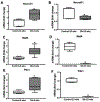Autonomous regulation of retinal insulin biosynthesis in diabetes
- PMID: 35660758
- PMCID: PMC10440820
- DOI: 10.1016/j.npep.2022.102258
Autonomous regulation of retinal insulin biosynthesis in diabetes
Abstract
Diabetic retinopathy (DR) is a neurodegenerative disease that results as a complication of dysregulated glucose metabolism, or diabetes. The signaling of insulin is lost or dampened in diabetes, but this hormone has also been shown to be an important neurotrophic factor which supports neurons of the brain. The role of local insulin synthesis and secretion in the retina, however, is unclear. We have investigated whether changes in local insulin synthesis occur in the diabetic retina and in response to stressors known to initiate retinal neurodegenerative processes. The expression of insulin and its cleavage product, c-peptide, were examined in retinas of a Type I diabetes animal model and human postmortem donors with DR. We detected mRNAs for insulin I (Ins1), insulin II (Ins2) and human insulin (Ins) by quantitative real-time polymerase chain reaction (qRT-PCR) and in situ hybridization. Using an ex-vivo system, isolated neuroretinas and retinal pigmented epithelium (RPE) layers were exposed to glycemic, oxidative and inflammatory environments to measure insulin gene transcripts produced de novo in the retina under disease-relevant conditions. The expression of insulin in the retina was altered with the progression of diabetes in STZ mice and donors with DR. Transcription factors for insulin, were simultaneously expressed in a pattern matching insulin genes. Furthermore, de novo insulin mRNA in isolated retinas was induced by acute stress. RPE explants displayed the most pronounced changes in Ins1 and Ins2. This data reveals that the retina, like the brain, is an organ capable of producing local insulin and this synthesis is altered in diabetes.
Keywords: C-peptide; Diabetes; Diabetic retinopathy; Insulin; Retina; Retinal pigmented epithelium.
Copyright © 2022 The Authors. Published by Elsevier Ltd.. All rights reserved.
Figures






References
-
- Arden GB, and Sivaprasad S. 2011. 'Hypoxia and oxidative stress in the causation of diabetic retinopathy', Curr Diabetes Rev, 7: 291–304. - PubMed
-
- Barber AJ, Nakamura M, Wolpert EB, Reiter CE, Seigel GM, Antonetti DA, and Gardner TW. 2001. 'Insulin rescues retinal neurons from apoptosis by a phosphatidylinositol 3-kinase/Akt-mediated mechanism that reduces the activation of caspase-3', J Biol Chem, 276: 32814–21. - PubMed
-
- Das A, Pansky B, Budd GC, and Kollarits CR. 1984. 'Immunocytochemistry of mouse and human retina with antisera to insulin and S-100 protein', Curr Eye Res, 3: 1397–403. - PubMed

